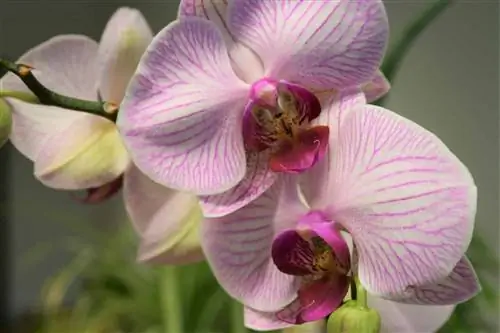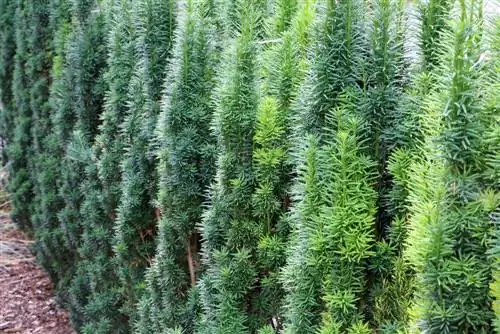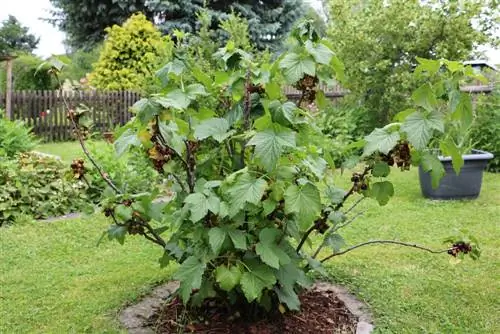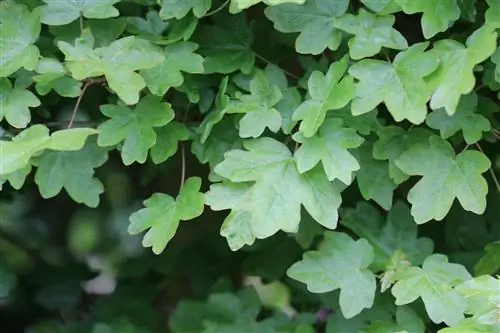- Author admin [email protected].
- Public 2023-12-17 03:39.
- Last modified 2025-01-24 12:45.
Hydrangeas are versatile and multifaceted plants. While some of the numerous Hydrangea species are cultivated as ornamental shrubs in the garden, other varieties shine in full bloom on the windowsill. A growth height of up to 3 meters and 30 cm long flower umbels are not uncommon for classic hydrangea species. The popular spring and summer bloomers place high demands on the location and also on care. Some varieties are susceptible to frost and should under no circumstances be left unprotected outdoors in the winter months.
Location & Substrate
Almost all hydrangea varieties feel extremely comfortable in partially shaded to shady locations. Some species can also cope with full sun planting locations as long as the substrate has sufficient moisture. Recommended if you also protect the water-loving hydrangeas from the direct midday sun. Every location should be well ventilated and cool, which promotes the flowering of the plants belonging to the stone crusher family. The plants with spherical or plate-shaped flowers are also suitable for cultivation in containers.
Hydrangeas have a special feature: the pH value of the soil influences the flower color. When using acidic soil, pink and red flowering plants turn blue. To specifically achieve this effect, you can use rhododendron soil, for example, whose pH value is slightly alkaline. However, this value has no influence on white-flowering Hydrangea species; the flower color does not change. A mixture of potting soil with humus and peat is gratefully accepted by all hydrangeas.
Watering & Fertilizing
Significantly fluctuating temperatures and short-term drought place excessive strain on sensitive plants. Water regularly; the root ball of the plants must never dry out. On hot summer days, hydrangeas often need to be watered several times a day. This is particularly true for plants in pots, as they are particularly at risk from the substrate drying out quickly. For plants in containers, it is particularly important to water correctly. Because the risk of waterlogging or root rot is also high for these moisture-requiring plants.
You shouldn't be skimpy with nutrients when it comes to hydrangeas. From March to August you should regularly supply the plants, also known as “water hose”, with a special hydrangea fertilizer. Azalea and rhododendron fertilizer has also proven itself and sufficiently meets the hydrangea's nutritional requirements. Fertilizer containing aluminum has proven effective for blue-flowering hydrangeas. From September onwards, the administration of nutrients is stopped and the plant itself takes a break from vegetation.
Plants
Hydrangeas purchased from specialist retailers are not repotted, but experience their first flowering in the pot purchased. Immediately after flowering, you can move the sensitive plants outdoors or repot them into a larger planter. Choose a location that meets the requirements of the respective hydrangea variety. The farmer's hydrangea, for example, is one of the more robust species and can easily cope with sunny planting locations. Hydrangea arborescens, on the other hand, which is nicknamed “forest hydrangea”, prefers a partially shaded location. The space requirements of individual varieties should also be taken into account.
- Loose the soil sufficiently.
- Remove dead root residues and weeds.
- Mix the soil with peat and compost.
- Dig a sufficiently large planting hole.
- Insert hydrangea up to the upper edge of the root.
- Voids can be eliminated by moving the plant back and forth.
- Fill the substrate back completely and press it firmly.
- Pour vigorously.
Hydrangeas in pots require drainage made of porous material at the bottom of the container. This will prevent standing moisture in the planter. Choose a sturdy container that is about 4 to 5 cm larger than the plant's root ball.
Propagate
Hydrangea varieties can be successfully propagated using annual head and stem cuttings. The shoots are taken in June or July and rooted directly on the windowsill at home.
- The cuttings are shortened to 15 cm.
- All foliage is removed except for two pairs of upper leaves.
- Place the shoots in lean substrate.
- Propagation takes place outdoors or on the windowsill in cool temperatures.
- From autumn onwards, the cuttings must be moved to a protected location.
- You can transplant the young hydrangeas outdoors next spring.
Tip:
Climbing hydrangeas can also be successfully propagated using planters.
Cutting
How the correct cut is made depends on the respective hydrangea variety. A larger thinning or shape cut is not necessary for many species. It is usually enough to completely remove dead shoots or shoots affected by fungal pathogens. Pruning done incorrectly can even have a negative effect on flower formation. Late-flowering varieties, such as panicle hydrangeas and forest hydrangeas, tolerate severe pruning in the cold season. This promotes the bushy shoots of the plants and the splendor of flowers. Early flowering species should be left to their own devices; if necessary, pruning is carried out immediately after flowering.
Wintering
Many of the hydrangea varieties available in specialist stores are hardy. Treat the plants to a warming layer of bark mulch or brushwood to prevent frost damage to the shoots. In spring you can protect the young shoots and early flowering of hydrangeas and garden hydrangeas from late frosts with a special fleece. In hardy areas, potted plants should move to bright, frost-free winter quarters by October at the latest. The temperature here should not exceed 3 °C to 6 °C to prevent the plants from turning yellow. Larger planters can be left outdoors in regions with mild winters. Wrap the bucket with a warming fleece or burlap.
Varieties
The approximately 70 hydrangea varieties are represented worldwide, the diversity varies between deciduous and evergreen species. The different varieties also differ in their growth. While some develop into bushes, others climb upwards or grow directly as small trees. Many of the Hydrangea species available in specialist stores are specially bred hybrid varieties that reach a maximum height and projection of around 55 cm.
- Hydrangea macrophylla: Also known as “farmer’s hydrangea”, classic beauty in the cottage garden. The flower color of the 2 meter high growing plants varies between blue, white and pink.
- Hydrangea petiolaris: “Climbing hydrangeas” are extremely robust and do not require any special protection, even in winter. The plant, which grows up to 7 meters high, forms adhesive roots.
- Hydrangea arborescens: “Forest hydrangeas” are ideal for planting in partial shade. With a height of 3 meters, the variety is still one of the low-growing hydrangeas.
- Hydrangea paniculata: “Panel hydrangeas” can reach several meters in height and form lilac-like inflorescences. The variety copes easily with sunny locations, but requires moist and lime-poor soil.
- Hydrangea serrata: “Plate hydrangeas” reach a maximum height of 2 meters, the plate-shaped umbels of the flower gave the plant its name.
Conclusion of the editors
Hortensias are classic and timeless flowering plants that should not be missing from any ornamental or cottage garden. With a little skill, the passionate hobby gardener can transform red and pink flowers into blue-flowering beauties. The amount of care and demands required for many Hydrangea species seems more complicated than it actually is.
What you should know about Hydrangea in brief
Care
- When caring for the hydrangea, the most important thing is to provide it with enough water.
- Such a plant must never dry out, so care should be taken especially at high temperatures.
- But it also doesn't tolerate waterlogging, which is why excess water should always be removed from the planter for potted hydrangeas.
- The hydrangea needs a lot of water during the flowering period.
- It's best not to cut a hydrangea at all, but if it's absolutely necessary, it can easily be thinned out.
- Under no circumstances should it be cut back severely, as it forms the buds for the following year while it is flowering.
- If you cut it hard, the flower will fail the next year. An exception to this are the varieties that also produce flowers on annual shoots.
flower colors
Garden hydrangeas bloom white, purple, pink, pink or red. The color of the flowers is caused by the pigment delphinidin they contain, which causes different flower colors depending on the pH value of the soil. Low pH values produce purple flowers, high pH values produce pink or red flowers. Only the varieties with white flowers do not change color. Hydrangeas with blue flowers are also very popular. These are varieties that actually bloom pink, but aluminum sulfate or alum is added to the potting soil, which turns the flowers blue. These substances are contained in the special fertilizers for blue hydrangeas. If a plant is only fertilized irregularly, it can happen that both pink and blue flowers are formed.






